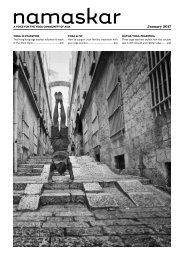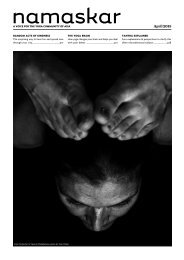Namaskar July 2010
You also want an ePaper? Increase the reach of your titles
YUMPU automatically turns print PDFs into web optimized ePapers that Google loves.
Dristi Tapas<br />
Tan<br />
antr<br />
tra on Tap<br />
apas<br />
as<br />
Yogesvara Sarasvati<br />
GRATITUDE TO MY GURU’S GURU, PARAMAHAMSA SATYANANDA SARASVATI<br />
(“Swamiji”) who recently took Mahasamadhi [the act of consciously and intentionally<br />
leaving one’s body at the time of death] and is largely responsible for re-invigorating the<br />
tradition of classical Tantra and Hatha Yoga in our modern context.<br />
In Swamiji we find the expression of a real<br />
tried and true yogi – fully established in the<br />
view, methods and ultimate fruit of<br />
authentic yoga practice. In his authoritative<br />
commentary on the seminal text, the Hatha<br />
Yoga Pradipika by Swami Swatmarama,<br />
Swamiji deals adeptly with the topics of<br />
tapas, yama and niyama – subjects that have<br />
become associated with so much of<br />
modern commercial yoga.<br />
Swamiji writes, “The beauty of the Hatha<br />
Yoga Pradipika is that it solves a very great<br />
problem faced by every aspirant.<br />
Swatmarama completely eliminated the<br />
yama (moral codes) and niyama (selfrestraints)<br />
which are the starting points in<br />
the Buddhist and Jain systems, as well as in<br />
Patanjali’s raja yoga” (and the majority of<br />
commercial yoga today). Swamiji continues,<br />
“the contention is that you have to first<br />
When one tries to impose lofty codes of moral<br />
conduct on a body in disharmony, one’s practice<br />
actually becomes a hindrance<br />
perfect yama and niyama, otherwise asana<br />
and pranayama may fail to give desirable<br />
results.” But, yogis have long been aware<br />
of the “practical difficulties every person<br />
faces in relation to yama and niyama.<br />
Moreover, yama and niyama have more to<br />
do with religion than with a person’s<br />
spiritual life.”<br />
He continues, “often we observe that when<br />
we try to practice self-control and discipline,<br />
we create more mental problems in our<br />
mind and personality… Therefore, before<br />
you practice self-discipline and self-control,<br />
you must also prepare yourself.”<br />
The non-dual Tantrik perspective is amoral<br />
and cares only about desirable results<br />
(freedom) and appropriate responses. We<br />
do not judge aberrant behavior because we<br />
know it is simply the result of imbalanced<br />
chemistry in the body/mind/spirit. We<br />
understand one cannot practice yama and<br />
niyama to be able to practice hatha yoga and<br />
pranayama, but rather one must practice<br />
hatha yoga and pranayama to be able to<br />
express appropriate behavior in response to<br />
one’s environment.<br />
wrestle with the mind, yet you wrestle with<br />
it, thereby creating a pattern of animosity<br />
towards yourself.” When one’s desires and<br />
impulses are at odds with their moral ideas<br />
of how things should be, “there are not<br />
two minds, there is one mind trying to<br />
split itself into two. One mind wants to<br />
break the discipline and the other mind<br />
wants to maintain the discipline. You can<br />
find this split in everybody. When this<br />
split becomes greater, then we call it<br />
schizophrenia.”<br />
It is said the mind is most difficult to<br />
tame, and the body is more accessible for<br />
practitioners to work with. When one tries<br />
to impose lofty codes of moral conduct or<br />
harsh disciplines on a body that is in a state<br />
of disharmony then one’s practice actually<br />
becomes a hindrance rather than the tool<br />
of liberation yoga is intended to be.<br />
Swamiji says, “this danger was clearly<br />
realized by the authorities and masters of<br />
hatha yoga. Therefore, they said, first<br />
discipline the body,” then, one will<br />
effortlessly express the inherent human<br />
virtues of compassion, wisdom,<br />
unconditional love and respect – the yama<br />
and niyama will take care of themselves.<br />
Otherwise, when one tries to force<br />
discipline and control on the mind through<br />
codes like yama/niyama, the ten<br />
commandments – the result is what<br />
Swamiji calls “spiritual schizophrenia.”<br />
This is obviously a far cry from the original<br />
intention of hatha yoga, which is “for<br />
those who wish to ascend to the highest<br />
stage of yoga, raja yoga (i.e. total<br />
enlightenment).”<br />
Yogi is the co-founder of Energy of Mind<br />
Therapy (www.energyofmindtherapy.com ),<br />
the practice of<br />
psychotherapy that draws<br />
on Tantra, Yoga and<br />
Aryuveda. He lives in a<br />
community of Tantrik<br />
yogins, along with his wife<br />
and child, at the rural Thai<br />
retreat center: Kailash<br />
Akhara - home of Adi<br />
Yoga (www.adiyoga.com )<br />
Swamiji questions, “Why do you fight with<br />
the mind first? You have no power to<br />
12

















